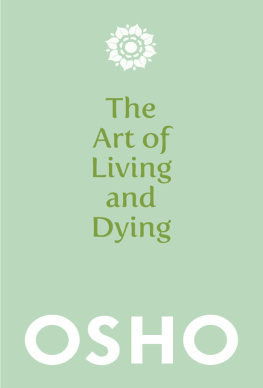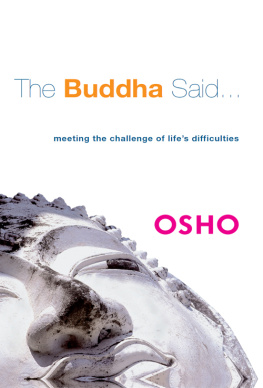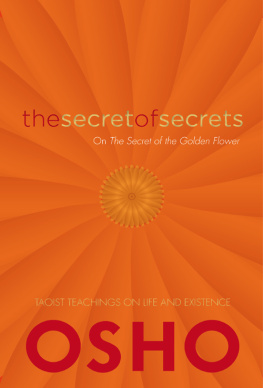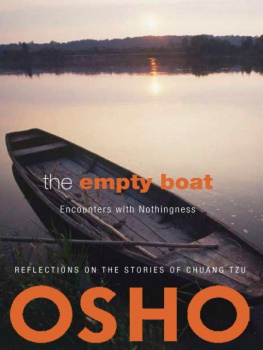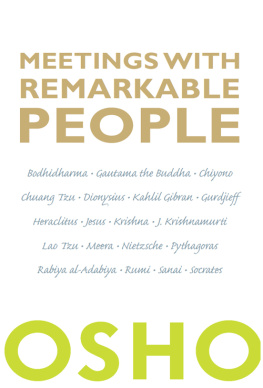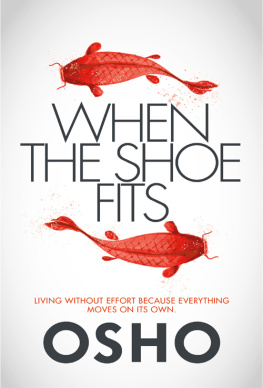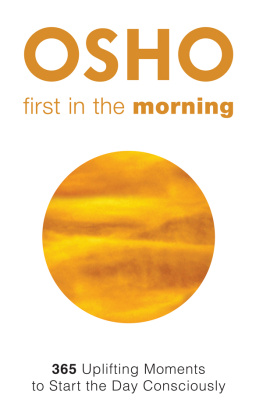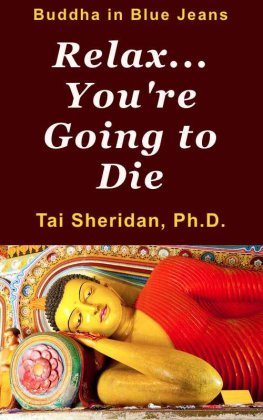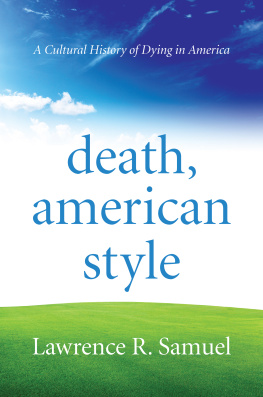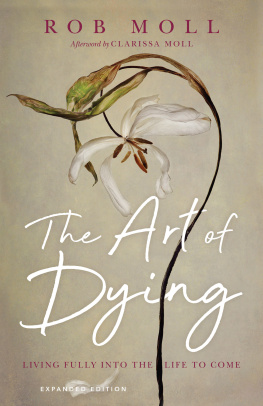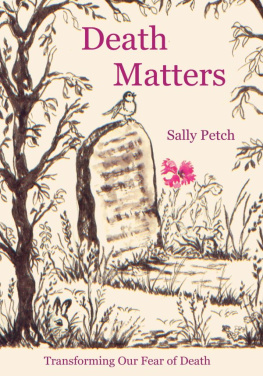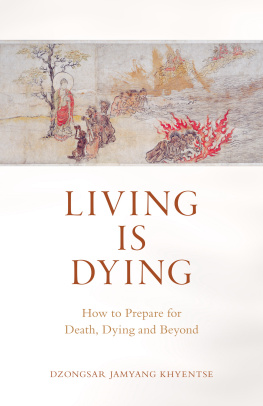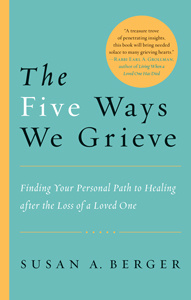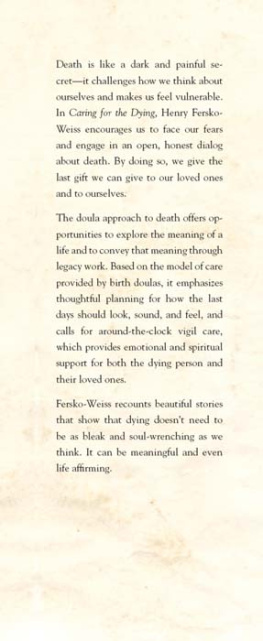ABOUT THE AUTHOR
The Osho teachings defy categorization, covering everything from the individual quest for meaning to the most urgent social and political issues facing society today. His books are not written but are transcribed from audio and video recordings of extemporaneous talks given to international audiences over a period of 35 years. Osho has been described by the Sunday Times in London as one of the 1,000 Makers of the 20th Century and by American author Tom Robbins as the most dangerous man since Jesus Christ.
About his own work Osho has said that he is helping to create the conditions for the birth of a new kind of human being. He has often characterized this new human being as Zorba the Buddha capable both of enjoying the earthy pleasures of a Zorba the Greek and the silent serenity of a Gautama Buddha. Running like a thread through all aspects of Oshos work is a vision that encompasses both the timeless wisdom of the East and the highest potential of Western science and technology.
Osho is also known for his revolutionary contribution to the science of inner transformation, with an approach to meditation that acknowledges the accelerated pace of contemporary life. His unique Active Meditations are designed to first release the accumulated stresses of body and mind, so that it is easier to experience the thought-free and relaxed state of meditation.
OSHO books also published by Watkins Publishing
Living Dangerously (Masters of Wisdom)
When the Shoe Fits
Inner War and Peace
The Buddha Said
Meetings With Remarkable People
Tantra: The Supreme Understanding
The
Art of
Living
and
Dying
OSHO
Contents
Part 1
Taking on the Last Taboo
Part 2
Unknown Journey: Understanding and Facing Our Fears
Part 3
Milestones on the Path
Part 4
Time to Say Goodbye: Insights for Caretakers and the Bereaved
Afterword
A Snowflake Dissolving in Pure Air
INTRODUCTION
Life is spread out over a long time seventy years, one hundred years. Death is intense because it is not spread out it is in a single moment. Life has to pass one hundred years or seventy years, it cannot be so intense. Death comes in a single moment; it comes whole, not fragmentary. It will be so intense you cannot know anything more intense. But if you are afraid, if before death comes you have escaped, if you have become unconscious because of the fear, you have missed one of the golden opportunities, the golden gate. If your whole life you have been accepting things, when death comes, patiently, passively you will accept and enter into it without any effort to escape. If you can enter death passively, silently, without any effort, death disappears.
In the Upanishads there is an ancient story that I have always loved. A great king named Yayati became one hundred years old. Now it was enough; he had lived tremendously. He had enjoyed all that life could make available. He was one of the greatest kings of his time. But the story is beautiful...
Death came and said to Yayati, Get ready. It is time for you, and I have come to take you. Yayati saw Death, and he was a great warrior and he had won many wars. Yayati started trembling, and said, But it is too early. Death said, Too early! You have been alive for one hundred years. Even your children have become old. Your eldest son is eighty years old. What more do you want?
Yayati had one hundred sons because he had one hundred wives. He asked Death, Can you do a favor for me? I know you have to take someone. If I can persuade one of my sons, can you leave me for one hundred years more and take one of my sons? Death said, That is perfectly okay if somebody else is ready to go. But I dont think... If you are not ready, and you are the father and you have lived more and you have enjoyed everything, why should your son be ready? Yayati called his one hundred sons. The older sons remained silent. There was great silence, nobody was saying anything. Only one, the youngest son who was only sixteen years of age, stood up and he said, I am ready. Even Death felt sorry for the boy and said to the young man, Perhaps you are too innocent. Cant you see your ninety-nine brothers are absolutely silent? Someone is eighty, someone is seventy-five, someone is seventy-eight, someone is seventy, someone is sixty they have lived but they still want to live. And you have not lived at all. Even I feel sad to take you. You think again.
The boy said, No, just seeing the situation makes me completely certain. Dont feel sad or sorry; I am going with absolute awareness. I can see that if my father is not satisfied in one hundred years, what is the point of being here? How can I be satisfied? I am seeing my ninety-nine brothers; nobody is satisfied. So why waste time? At least I can do this favor to my father. In his old age, let him enjoy one hundred years more. But I am finished. Seeing the situation that nobody is satisfied, I can understand one thing completely that even if I live one hundred years, I will not be satisfied either. So it doesnt matter whether I go today or after ninety years. You just take me.
Death took the boy. And after one hundred years he came back. And Yayati was in the same position. And he said, These hundred years passed so soon. All my old sons have died, but I have another regiment. I can give you some son. Just have mercy on me.
It went on the story goes on to say for one thousand years. Ten times Death came. And nine times he took some son and Yayati lived one hundred years more. The tenth time Yayati said, Although I am still as unsatisfied as I was when you came for the first time, now although unwillingly, reluctantly I will go, because I cannot go on asking for favors. It is too much. And one thing has become certain to me, that if one thousand years cannot help me to be contented, then even ten thousand will not do.
It is the attachment. You can go on living but as the idea of death strikes you, you will start trembling. But if you are not attached to anything, death can come this very moment and you will be in a very welcoming mood. You will be absolutely ready to go. In front of such a man, death is defeated. Death is defeated only by those who are ready to die any moment, without any reluctance. They become the immortals, they become the buddhas.
This freedom is the goal of all religious search. Freedom from attachment is freedom from death. Freedom from attachment is freedom from the wheel of birth and death.
Freedom from attachment makes you capable of entering into the universal light and becoming one with it. And that is the greatest blessing, the ultimate ecstasy beyond which nothing else exists. You have come home.
Part 1
TAKING ON THE
LAST TABOO
Death cannot be denied by repeating that death does not exist.
Death will have to be known, it will have to be encountered,
it will have to be lived.
You will have to become acquainted with it.
1
In search of the Deathless
God is not really the center of religious inquiry, death is. Without death there would have been no religion at all. It is death that makes man seek and search for the beyond, the deathless.
Death surrounds us like an ocean surrounding a small island. The island can be flooded any moment. The next moment may never come, tomorrow may never arrive. Animals are not religious for the simple reason that they are not aware of death. They cannot conceive of themselves dying, although they see other animals dying. It is a quantum leap from seeing somebody else dying to concluding that I am also going to die. Animals are not so alert, aware, to come to such a conclusion.

